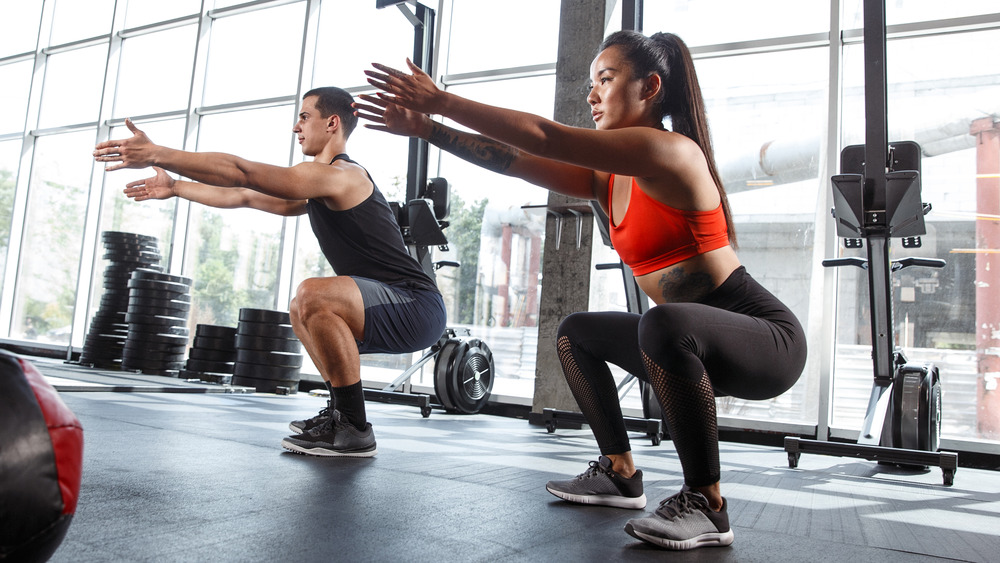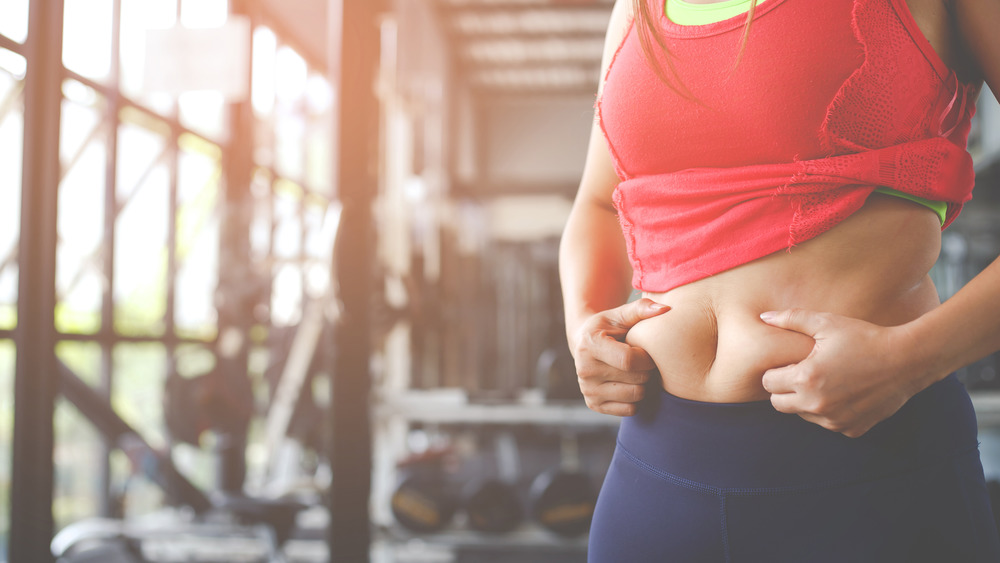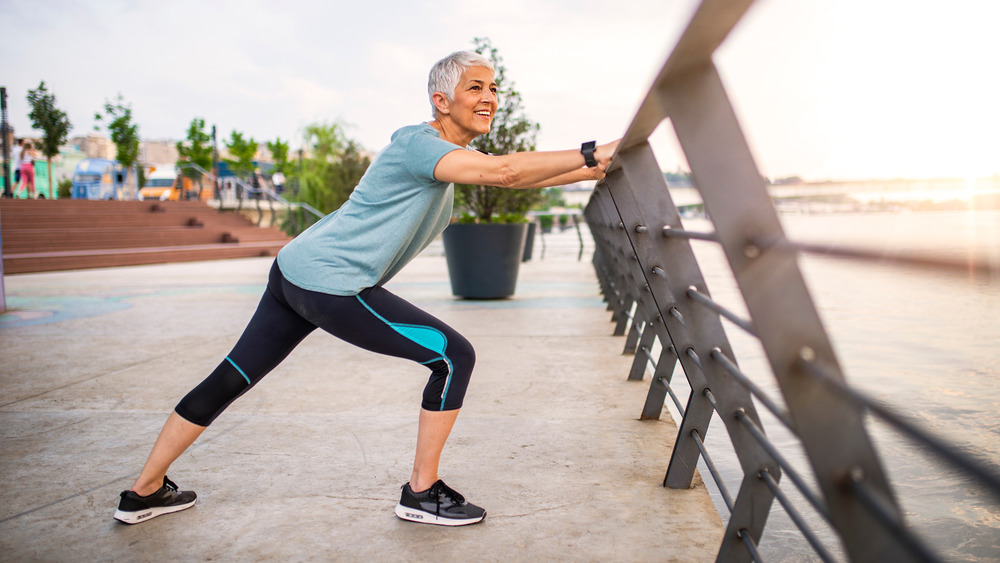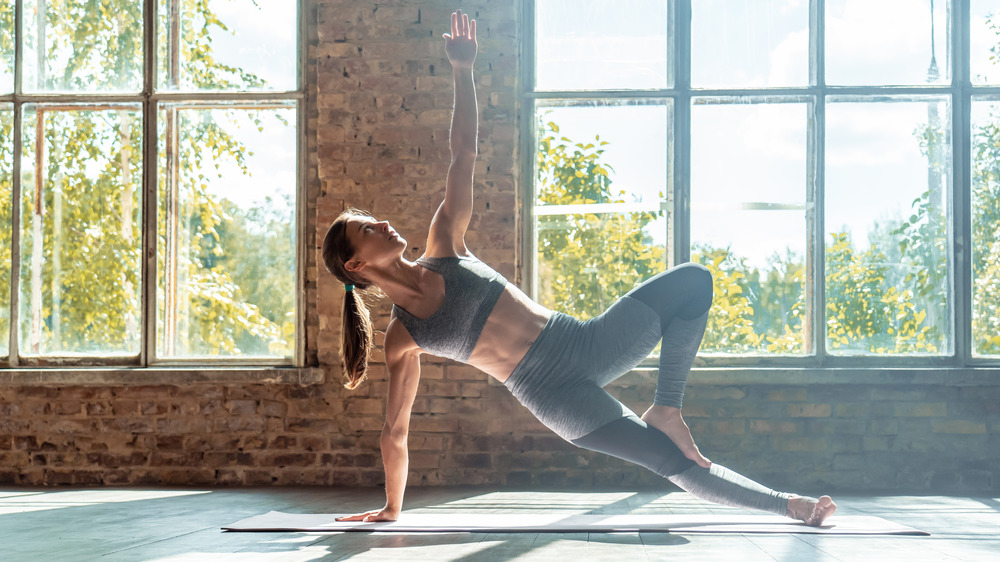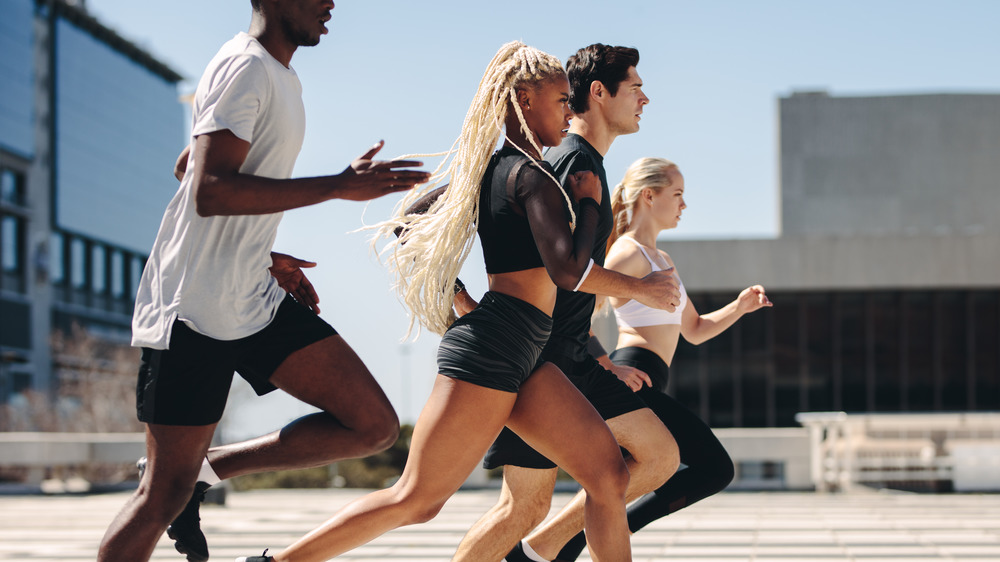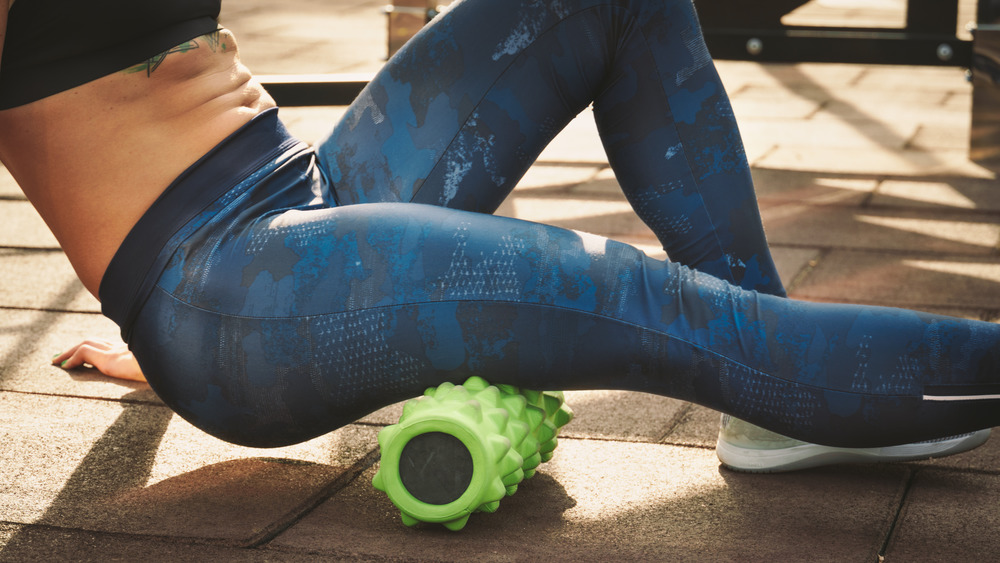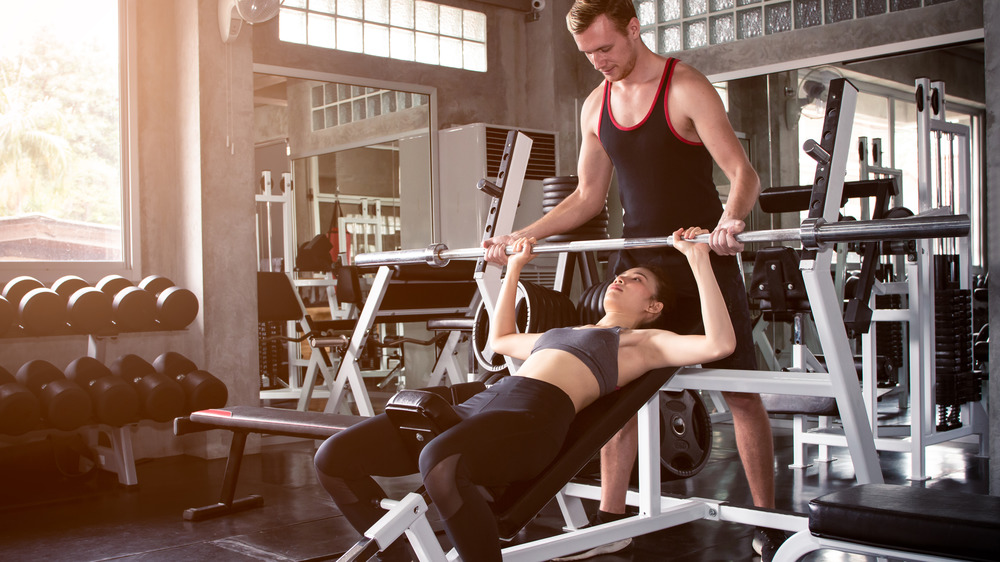Workout Myths You Need To Stop Believing
Workout myths continue to persist even with all the expert information readily available in books, magazines, and of course, the internet. Part of the issue is, of course, that people talk. A semi-plausible myth gets shared in a locker room or in a PE class, and it then gets passed along to another person, then the next, without anyone stopping to double-check the facts. This is especially true when people share anecdotal stories of their own fitness or nutrition journey ("Well, this worked for me, so it's bound to work for you!").
Another issue is when outdated only partially accurate information that's specific to a certain demographic gets shared, but the details get lost in translation. And, as fitness expert and personal trainer Elliott White, pointed out in an article for TFN Training, health science isn't perfect. Small studies that are extrapolated to the general public end up sharing ideas that may not be well-tested. The good news? Almost all consistent exercise is good for you. However, if you're trying to purge fitness myths from your own subconscious, these are a good place to start.
Myth: Spot reduction for weight loss is possible
The reason why infomercial abdominal products continue to be a mainstay of late-night viewing is that people are hooked on the idea of spot reduction. Everyone has "trouble zones" they'd love to tone up without having to do the hard, consistent work of making dietary changes and exercising three to five days a week. Unfortunately, you can't just do sit-ups to end up with killer abs. This is especially true if you're looking to achieve fat loss.
Fitness expert Chris McGrath explained in an article for the American Council on Exercise that the areas people usually want to "tone up" involve relatively small muscle groups, like the inner thighs, triceps, or, of course, the abs. While exercising these areas can help develop increased strength and muscle mass, the exercises themselves typically aren't going to increase metabolism enough to burn significant calories to help lead to weight loss.
Ultimately, if you want to see changes in body composition in specific areas of your body, you need to view fitness from a wider angle and stick with consistent, whole-body exercises and a well-balanced diet.
Myth: No pain, no gain
There's a little bit of truth when it comes to the old adage "no pain, no gain" — but it's all in how "pain" is being interpreted. When it comes to exercise, a little bit of muscle soreness in the days following a workout is completely normal and expected. And yes, you do need to push yourself a little past your comfort zone during workouts to keep seeing results. For example, if you're trying to build muscle mass, you need to increase the weight or adjust your sets and reps regularly to keep experiencing muscle fatigue.
That said, you should not be pushing yourself to the point of throwing up or extreme muscle pain during a workout. Likewise, if you've pushed yourself so hard that you feel physically sick or sore for days, you're doing too much. As professional fitness trainer David Williams stated for Cooper Aerobics, the best way to measure a good workout is to "quantify it." Don't look to soreness as your barometer for workouts; rather, keep track of your program and, every few weeks, increase your workload or time, aiming to beat your previous numbers.
Myth: You need to stretch before exercise
Don't misunderstand: Stretching, or flexibility training, is an incredibly important part of a well-balanced workout routine. However, the idea that stretching before a workout is absolutely necessary or that it helps prevent injuries is actually a long-standing myth. As William Kormos, internal medicine specialist and editor-in-chief of Harvard Men's Health Watch pointed out, studies indicate that static stretching before exercise doesn't prevent injury or soreness, and a gradual warm-up is a better option than this style of stretching.
Instead of running a lap and then doing 10 minutes of stretches for relatively cold muscles, focus more on exercises that help warm up your muscles while taking them through a full range of motion — especially exercises that mimic whatever workout you plan to do for the day. For instance, if you plan on strength training your legs, warm up your lower body with five to seven minutes on a bike, then do a series of squats and lunges using no more than your body weight before loading up the squat rack. Save your actual stretching routine for after you exercise when your muscles are warm and more pliable.
Myth: Yoga isn't a real workout
It's almost inconceivable that some people continue to believe that yoga isn't a "real" workout. This myth seems to hinge on the misguided concept that if a workout doesn't result in a heaving chest or buckets of sweat, it's not "worth" it. However, in all likelihood, this misconception exists among those who have never tried it.
For one thing, yoga isn't just lying on a yoga mat listening to soothing music and gongs (although it certainly can be). Yoga as a physical practice consists of many challenging poses and holds that require balance, stability, coordination, and strength. When these poses are put together into a flow, they can also increase heart rate and offer a moderate cardiovascular benefit.
As pointed out in an article for Harvard Health, the health benefits of yoga are many and include improved body image, enhanced all-around fitness (including strength, balance, flexibility, and cardiovascular health), improved mindfulness about food, and better overall mental health and well-being. When it comes to what a "real" workout is, anything that gets you moving and offers health-related benefits is a "real" workout — yoga, included.
Myth: You can be a couch potato as long as you work out regularly
Wouldn't it be so nice if you could log a 30-minute workout every day then feel good about lying around on the couch for the remaining hours of the day? Unfortunately, the myth that logging a workout means you've "earned" being a couch potato doesn't actually pan out in the real world.
According to a 2017 study published in the Annals of Internal Medicine, even if people log exercise or activity in their day, prolonged, uninterrupted bouts of sedentary behavior were associated with all-cause mortality. In other words, failing to move around on a regular basis throughout your day can increase risk of death. The takeaway being that you should log your daily workouts, but also make sure you're staying active outside of the gym. This can mean standing up and walking around at least once an hour, doing housework or yard work, pacing while talking on the phone, or meeting friends for active activities, rather than long bouts of sitting.
The lead author of the study, Keith Diaz, told CNN Health that for every 30 minutes of sitting you do, you should get up and move around for five minutes. This can help reduce the health risks from sitting.
Myth: A boxing workout is a good physical outlet for anger
When you're really mad, and you really want to punch someone, it makes sense to take your anger out on a punching bag instead of a person, right? It just makes sense that knocking out a few jabs and kicks would help you release your anger, lower your stress, and cut down on those aggressive feelings.
Unfortunately, research indicates that this type of catharsis doesn't work. When research participants who were manipulated into a state of anger were given the opportunity to punch a punching bag or to sit quietly, they found that those who punched the punching bag actually displayed more aggressive behavior later in the experiment, according to a Psychology Today article written by psychologist Art Markman.
As Markman wrote, "Punching a punching bag makes a connection for people between anger and aggression. That is, it reinforces the link between being angry and acting in an aggressive manner. These connections between emotional states and behavior are an important part of what determines the way we act." So if you're trying to reduce your anger and aggression, try meditating or other forms of calming exercise.
Myth: Relieving your stress through an intense workout is good for you
Exercise is a great way to improve mental health. And yes, that means exercise can be a good way to help manage anger, too. That said, when you're red hot with rage, pounding the pavement at a breakneck speed or trying to lift more weight than you're used to may not be the best idea.
A study published in Circulation found that engaging in high-intensity exercise while stressed out or angry was tied to an increased risk of heart attack within an hour of the exertion (via AP News). The study leader, Dr. Andrew Smyth of McMaster University, explained that emotional stress and physical exertion both raise blood pressure and heart rate while also changing the flow of blood to vessels, reducing the heart's blood supply. If arteries are already clogged, these changes in circulation could lead to a heart attack.
"We continue to advise regular physical activity for all, including those who use exercise to relieve stress," Smyth told AP News, but he added that during times of high stress, workouts should be more moderated — it's not the time to go all out.
Myth: Evening workouts will prevent a good night's sleep
If you're using your sleep schedule as an excuse not to hit the gym after work, it's time to rethink that reasoning. There's long been a rumor that working out in the evening can negatively impact your sleep. On the surface, the argument makes sense: Exercise stimulates your nervous system, increases your heart rate, boosts your body temperature, and, in general, revs up all of your systems. So if you get amped up before bed, how could exercise not interfere with your sleep? Well, in this case, the beneficial effects of exercise seem to outweigh any potential downsides — at least within reason.
According to a 2015 review published in the Journal of Behavioral Medicine, acute exercise (a single session) and regular exercise (an ongoing habit) both contribute to beneficial effects on sleep time and quality. That said, the closer a workout was performed to bedtime and the more challenging the workout, the lower the benefits to sleep. So if you need to work out in the evening, try to do it at least a few hours before bedtime, and consider sticking to moderate-intensity routines.
Myth: You need to increase your protein intake for maximum results
So here's the deal: Protein intake is incredibly important for muscle growth and repair, and that's particularly true after a workout. That said, just because protein intake is important, that doesn't mean you necessarily need to increase your intake to work out. Most Americans already consume roughly twice the recommended daily amount of protein, so actively increasing protein intake without paying attention to how much you're consuming doesn't make a lot of sense.
That said, protein recommendations for athletes have increased, with one study indicating that track and field athletes should consume two to three times more than previously recommended to help build lean muscle. But these recommendations don't mean anything if you don't know how much you're currently eating.
Before adding a supplement, keep a food journal for a week. Monitor how much protein you consume, then compare your intake to the recommendations. If you're consuming a lot of meat in your daily diet, you may realize you don't need a supplement at all.
Myth: Running is bad for your knees
Everyone knows a runner who has bad knees, right? So it makes sense to connect the dots; if my friend has bad knees and my friend likes to run then, surely, the bad knees are a result of the running, right? Not so fast.
A study published in the European Journal of Applied Physiology revealed that there's some indication that 30 minutes of running could actually reduce inflammation in runners' knees, which may indicate that running could actually help reduce the risk of injury (via Time). As Matt Seeley, the study author, told Time, "I think, and hope, the data shows that running is good for your joints," although he did go on to admit that the study was small and more data was needed.
Additionally, a 30-minute run is relatively short, and it's hard to say if there's a "sweet spot" for the protective benefits of running versus potentially harmful drawbacks. The overall takeaway is that running can't uniformly be considered "bad" for the knees or "good" for the knees; rather, runners should listen to their bodies and make adjustments to their training based on how their bodies respond.
Myth: Exercising while pregnant is dangerous
Pregnant women should always talk to their doctor about their exercise programs and whether their pregnancy or their specific exercise program carries any risks. But in general, the age-old myth that women should rest and avoid all exertion while pregnant has been dismantled. In fact, most doctors and hospital groups, including Jefferson University Hospitals, go so far as to encourage exercise during pregnancy.
A 2016 study published in the American Journal of Obstetrics and Gynecology found that women who exercised during pregnancy not only weren't at a greater risk for preterm labor, but they also were more likely to deliver vaginally, had a lower incidence of gestational diabetes, and had lower rates of high blood pressure.
While all forms of exercise — whether walking, swimming, or yoga — seem to impart these benefits, resistance training appears to have some unique benefits as well. According to a study from the University of Gothenburg, women who strength trained during pregnancy experienced some relief from pregnancy discomfort and symptoms, and had a greater sense of control. So if you're pregnant, feel up to it, and your doctor gives you the go-ahead, keep that workout routine going.
Myth: You need to hydrate with sports drinks when exercising
Sports drinks, like Gatorade, have a time and a place, but that's usually not in the gym bag of the average exerciser. While sports drinks are touted as an ideal way to rehydrate and replenish electrolytes after a workout, they're also packed full of sugars.
As pointed out on UW Health, most people don't need the added sugar or the sports drink, in general, stating, "If you're exercising heavily for longer than an hour, you may benefit from a sports drink to help replace carbohydrates and electrolytes. You need one 20-ounce bottle of sports drink for every hour you exercise, starting in the second hour. If you're not exercising this long, all you really need is water."
If you're only working out for about an hour and you're eating and drinking normally following your workout, you're going to naturally replenish your electrolytes and water with your normal diet. That said, if you're training for a marathon and you have a long-run scheduled for the weekend, go ahead and pack a sports drink — just remember, you won't need it until after your first hour of exercise is complete.
Myth: Delayed onset muscle soreness is caused by lactic acid buildup
Delayed onset muscle soreness (DOMS) — the soreness you experience about 24 to 48 hours after a tough workout — was long thought to be an effect of "lactic acid buildup" in the muscles. This, however, has been disproven with better studies into exercise physiology.
As explained to Lifehacker by Dr. Brian Parr, an exercise science professor at the University of South Carolina Aiken, the burn sensation you feel in your muscles during a workout is lactic acid. As your body tires, it has to use different systems to provide oxygen to working muscles. As these systems change, lactic acid, a byproduct of metabolism, builds up. That said, as soon as you stop exercising, any lactic acid buildup is removed and stops causing pain.
DOMS, on the other hand, is associated with small, microscopic tears in muscle fibers that happen during exercise. As you push yourself, your muscles experience damage, which results in inflammation and soreness. According to Dr. Parr, "This sounds bad, but the muscle damage is an important step in the muscle getting bigger and stronger." To reduce DOMS, ease your way into exercise, avoiding doing too much too soon.
Myth: Strength training bulks you up
This one goes out to the ladies. For unknown reasons, there's still a misconception that if women lift weights — especially heavy weights — they'll get bulky. But this is untrue. Exercise science professor Dr. Parr explained to Lifehacker, saying, "Exercise, especially strength training, can increase muscle mass. Some people believe that the added muscle mass leads to weight gain, not loss. If anything, exercise would help maintain muscle and promote fat loss."
For one thing, muscle mass is more dense than fat, so a pound of muscle takes up less space than a pound of fat. Also, muscle is a metabolically active tissue — it burns more calories at rest than fat does. So as you exercise regularly and gain muscle, you'll be more likely to burn more calories and lose more fat over time (especially when consuming a healthy diet). As you gain more muscle and lose more fat, you'll end up leaner and more compact, rather than bigger or bulkier.

